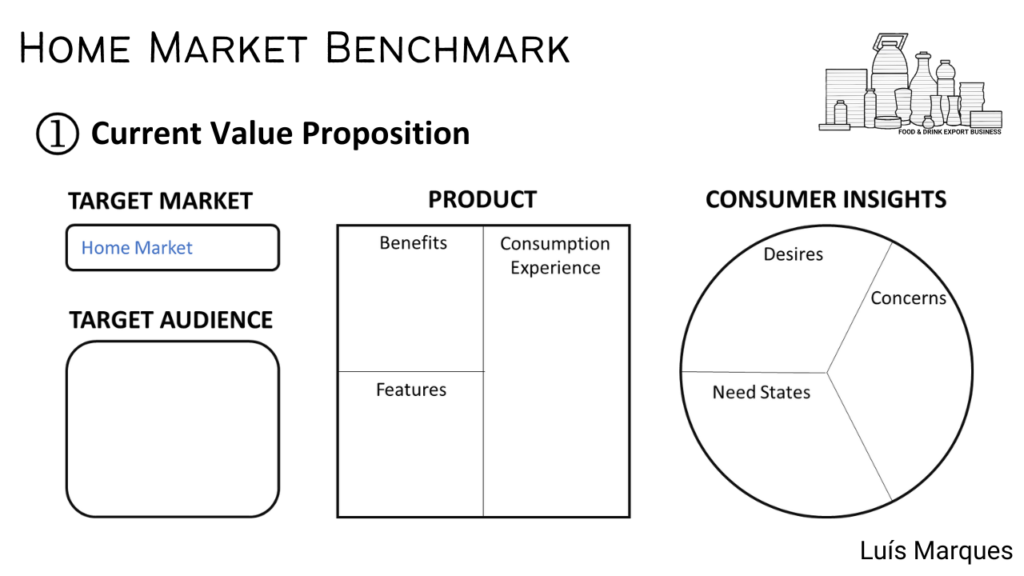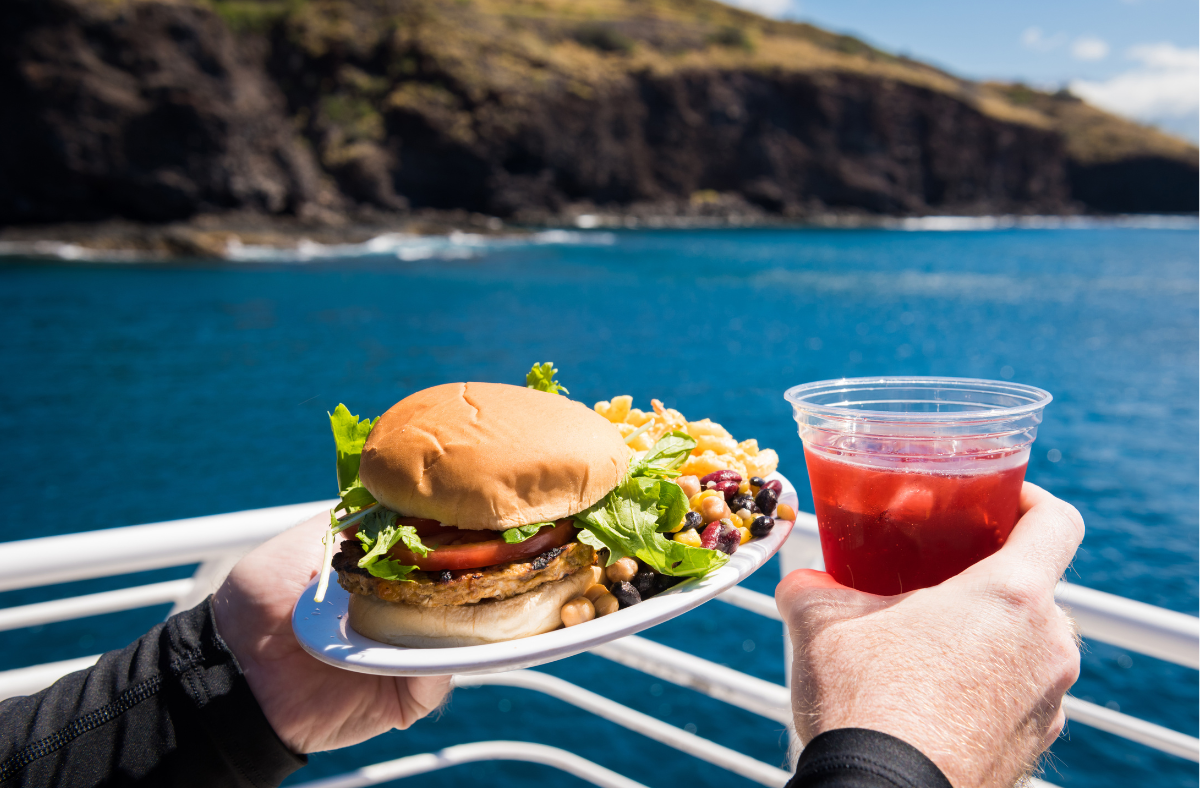When expanding a brand into a new international market, having a unique value proposition is essential. It is the defining factor that sets your brand apart from competitors and captures the attention of a new target audience.
Without a unique value proposition, your brand risks becoming just another brand in the aisle. That’s why building a unique value proposition is critical when you pioneer to a new market!
I found that having a structured framework to evaluate your market readiness can help you build and validate your value proposition.
Based upon Alexander Osterwalder and Peter Thomson’s work, I created a new framework more adapted to the food and drink industry which I think will help you develop your value proposition for any new markets.
This adapted framework comprises two main sections: Home Market Benchmark and Target Market Evaluation.
In this article I will explain the first section with more detail: Home Market Benchmark regarding the Current Value Proposition.
Home Market Benchmark – Current Value Proposition
Many in this industry initially try to sell the same products in new markets using the same arguments. However, the value proposition will be evaluated differently by consumers in a new target market. Nevertheless, it serves as a starting point.
This “Current Value Proposition Canvas” is divided into two parts: Your Product and the Consumer Insights based on your target audience in your home market.
Typically, your home market is where you have your strongest brand positioning and where you know the most about your consumers.
This intimate knowledge forms the basis for adapting your value proposition to a new market.

Product
Starting with your product, you need to answer three questions:
-
Benefits – What are the emotional attributes of your product that make your consumers’ lives better in your home market?
General emotional attributes for food and drink brands include:
- Brand Recognition: Confidence and pride in choosing a well-known and respected brand. These brands are often seen as a reference for quality or innovation within the category.
- Reliability and Trust: Security in consistent quality and safety standards. A brand that delivers on its promises.
- Celebration and Social Connection: Joy and uplift during special occasions with family or friends. Facilitates social interactions and creates a sense of community.
- Culture and National Pride: Pride in consuming products that celebrate cultural and national heritage. Emotional satisfaction from authentic products reflecting genuine practices.
- Nostalgia and Comfort: Bring fond memories and comfort from past experiences. Connection to cultural or familial traditions through food and drink.
- Satisfaction and Delight: Joy from consuming delicious and flavourful products. Pleasure in discovering new tastes and different cuisines from other parts of the world.
- Luxury and Indulgence: Pleasure from indulging in premium, high-quality products. Satisfaction from treating oneself as a reward.
- Health and Wellbeing: Enhanced health and energy from nutritious products. Comfort in making health-prioritized choices.
- Environmental Responsibility: Pride and satisfaction from supporting brands with sustainable practices, such as eco-friendly packaging and ethical sourcing.
-
Features – What are the functional attributes of your product in your home market?
General functional attributes for food and drink brands include:
- Taste and Flavour: The sensory experience, including taste, aroma, and mouthfeel.
- Nutritional Value: Health benefits like vitamins, minerals, protein, fibre, and essential nutrients.
- Convenience and Ease of Use: Ease of preparation and consumption.
- Quality and Freshness: Overall quality, including ingredients, manufacturing process, and freshness.
- Packaging: Design, functionality, and sustainability of the packaging.
- Price Positioning: Cost relative to perceived value and competitive landscape.
- Dietary Compliance: Suitability for specific dietary needs, such as gluten-free, vegan, or allergen-free.
- Shelf Life and Storage: Duration of freshness and safe consumption, and storage conditions.
- Sustainability and Ethical Sourcing: Environmental and ethical considerations in production, packaging, and distribution.
- Safety and Compliance: Adherence to safety standards and regulations, ensuring the product is free from harmful substances.
-
Consumption Experience – How does the experience of consuming your product make the consumer feel (consumer statement)?
When considering how the experience of consuming your product makes the consumer feel, it’s important to recognize that different types of target audiences may relate to your brand in unique ways.
By creating multiple personas, you can tailor consumer statements to reflect diverse emotional connections each segment may have.
This approach ensures your product resonates deeply with a wider range of consumers, enhancing overall brand connection.
Examples include:
- High-Protein Yogurt: “I feel strong and nourished after my workout, thanks to the high-protein content that helps me recover and build muscle without compromising on taste.”
- Fair-Trade Coffee: “I feel ethically responsible and connected to the global community, knowing my morning coffee supports fair trade practices and the wellbeing of farmers.”
- Classic Breakfast Cereal: “I feel nostalgic and comforted every morning when I enjoy a bowl of this classic cereal. It takes me back to my childhood, reminding me of carefree mornings and family breakfasts.”
Consumer Insights
Going next to the Consumer Insights, you will also need to answer three questions:
-
Desires – What are the emotional drivers that the consumer wants to be, do, or have?
- Status and Prestige: Products that elevate social status and reflect success, often premium or luxury goods.
- Indulgence and Pleasure: Products that provide enjoyment and sensory delight, often serving as treats or rewards.
- Health and Wellness: Motivation to improve health and maintain a balanced lifestyle.
- Convenience and Time Saving: Products that save time and effort, are easy to use, quick to prepare, or portable.
- Social and Cultural Identity: Products that resonate with cultural background or social identity, reinforcing a sense of belonging.
- Innovation and Novelty: Unique products that stand out and expand the palate, challenging and exciting consumers
-
Need States – What are the rational drivers that the consumer needs to get done?
- Basic Nutrition: Essential nutrients to maintain health and wellness.
- Compliance with Dietary Restrictions: Catering to specific dietary needs or restrictions.
- Safety and Quality: Assurance that products are safe to consume and of high quality.
- Affordability: Good value for money, competitively priced without compromising on quality.
- Availability and Accessibility: Easily accessible and consistently available in preferred shopping channels.
- Sustainability: Products produced sustainably, with minimal environmental impact and ethical sourcing practices.
-
Concerns – What are the Fears, doubts, and anxieties, a consumer might have while consuming your product?
- Healthy Ingredients: Concerns about the ingredients used in goods.
- Quality and Freshness: Concerns over the freshness and quality, especially for perishable or processed goods.
- Value for Money: Anxiety about not getting their money’s worth, seeking assurance that the product delivers on its promises.
- Regulatory Compliance: Concerns that products may not comply with local regulations, affecting safety and legality.
- Brand Trust and Authenticity: Doubts about the authenticity of brands, especially those making bold health claims or from unfamiliar sources.
- Cultural and Ethical Misalignment: Worries that products may not align with cultural practices or ethical values.
- Availability: Fear that preferred products may not always be available, leading to the need to find alternatives.
I will continue to develop the next subsections of the Home Market Benchmark of my Value Proposition Framework for the Food and Drink Industry newsletter. Check it out and subscribe on LinkedIn for more of my insights on the food & drink export business.







disqus comments